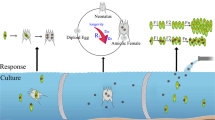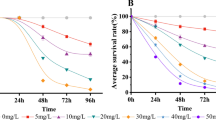Abstract
Carboxylated multi-walled carbon nanotubes (MWCNT-COOH) exerts strong adsorption capacity for pentachlorophenol (PCP) and they inevitably co-occur in the environment, but few studies have characterized the effects of MWCNT-COOH on the bioavailability of PCP and its oxidative and tissue damages to fish. In this work, we assessed the PCP accumulation in different organs and the induced oxidative and tissue damages of goldfish following 50-d in vivo exposure to PCP alone or co-exposure with MWCNT-COOH. Our results indicated that PCP bioaccumulation in goldfish liver, gill, muscle, intestine and gut contents was inhibited after co-exposure with MWCNT-COOH in uptake phase. PCP exposure alone and co-exposure with MWCNT-COOH evoked severe oxidative and tissue damages in goldfish bodies, as indicated by significant inhibition of activities of antioxidant enzymes, remarkable decrease in glutathione level, simultaneous elevation of malondialdehyde content, and obvious histological damages to liver and gill. The decreased accumulation of PCP in the presence of MWCNT-COOH led to the reduction of PCP-induced toxicity to liver tissues, as confirmed by the alleviation of hepatic oxidative damages. However, co-exposure groups had higher concentrations of PCP in the tissues than PCP treatment alone (p < 0.05 each) in the depuration phase, revealing that MWCNT-COOH-bound pollutants might pose higher risk once desorbed from the nanoparticles. These results provided substantial information regarding the combined effects of PCP and MWCNT-COOH on aquatic species, which helps to deeply understand the potential ecological risks of the emerging pollutants.






Similar content being viewed by others
Data availability
Some important data are available in the Supplementary Materials.
References
Chen CY, Jafvert CT (2010) Photoreactivity of carboxylated single-walled carbon nanotubes in sunlight: Reactive oxygen species production in water. Environ Sci Technol 44:6674–6679. https://doi.org/10.1021/es101073p
Chin CJ, Shih LC, Tsai HJ, Liu TK (2007) Adsorption of o-xylene and p-xylene from water by SWCNTs. Carbon 45:1254–1260. https://doi.org/10.1016/j.carbon.2007.01.015
Cho HH, Smith BA, Wnuk JD, Fairbrother DH, Ball WP (2008) Influence of surface oxides on the adsorption of naphthalene onto multiwalled carbon nanotubes. Environ Sci Technol 42:2899–2905. https://doi.org/10.1021/es702363e
Davood AF, HD MH, Chung TS (2017) Cross-linked mixed matrix membranes consisting of carboxyl-functionalized multi-walled carbon nanotubes and P84 polyimide for organic solvent nanofiltration (OSN). Sep Purif Technol 186:243–254. https://doi.org/10.1016/j.seppur.2017.06.021
De SF, Matsubara EY, Franchi LP, Martins IP, Ramires Rivera LM (2014) Evaluation of carbon nanotubes network toxicity in zebrafish (Danio rerio) model. Environ Res 134:9–16. https://doi.org/10.1016/j.envres.2014.06.017
Fang Q, Shi X, Zhang L, Wang Q, Wang X, Guo Y (2015) Effect of titanium dioxide nanoparticles on the bioavailability, metabolism, and toxicity of pentachlorophenol in zebrafish larvae. J Hazard Mater 283:897–904. https://doi.org/10.1016/j.jhazmat.2014.10.039
Ferguson PL, Chandler GT, Templeton RC, Demarco A, Scrivens WA, Englehart BA (2008) Influence of sediment-amendment with single-walled carbon nanotubes and diesel soot on bioaccumulation of hydrophobic organic contaminants by benthic invertebrates. Environ Sci Technol 42:3879–3885. https://doi.org/10.1021/es702830b
Flores LF, Thomaz AT (2011) Histopathologic alterations observed in fish gills as a tool in environmental monitoring. Braz J Biol 71:179–188. https://doi.org/10.1590/S1519-69842011000100026
Freixa A, Acuna V, Sanchis J, Farre M, Barcelo D (2018) Ecotoxicological effects of carbon based nanomaterials in aquatic organisms. Sci Total Environ 619-620:328–337. https://doi.org/10.1016/j.scitotenv.2017.11.095
Gao J, Liu L, Liu X, Zhou H, Huang S (2008) Levels and spatial distribution of chlorophenols, 2,4-dichlorophenol, 2,4,6-trichlorophenol, and pentachlorophenol in surface water of China. Chemosphere 71:1181–1187. https://doi.org/10.1016/j.chemosphere.2007.10.018
Ge T, Han J, Qi Y, Gu X, Ma L, Zhang C, Naeem S, Huang D (2017) The toxic effects of chlorophenols and associated mechanisms in fish. Aquat Toxicol 184:78–93. https://doi.org/10.1016/j.aquatox.2017.01.005
Kan H, Zhao F, Zhang XX, Ren H, Gao S (2015) Correlations of gut microbial community shift with hepatic damage and growth inhibition of Carassius auratus induced by pentachlorophenol exposure. Environ Sci Technol 49:11894–11902. https://doi.org/10.1021/acs.est.5b02990
Kolosnjaj TJ, Hartman KB, Boudjemaa S, Ananta JS, Morgant G, Szwarc H, Wilson LJ, Moussa F (2010) In vivo behavior of large doses of ultrashort and full-length single-walled carbon nanotubes after oral and intraperitoneal administration to Swiss mice. ACS Nano 4:1481–1492. https://doi.org/10.1021/nn901573w
Kondo T, Yamamoto H, Tatarazako N, Kawabe K, Koshio M (2005) Bioconcentration factor of relatively low concentrations of chlorophenols in Japanese medaka. Chemosphere 61:1299–1304. https://doi.org/10.1016/j.chemosphere.2005.03.058
Lee JW, Choi YC, Kim R, Lee SK (2015) Multiwall carbon nanotube-induced apoptosis and antioxidant gene expression in the gills, liver, and intestine of Oryzias latipes. Biomed Res Int 2015:485343. https://doi.org/10.1155/2015/485343
Linard EN, van den HP, Karanfil T, Apul OG, Klaine SJ (2015) Influence of carbon nanotubes on the bioavailability of fluoranthene. Environ Toxicol Chem 34:658–666. https://doi.org/10.1002/etc.2853
Lu CS, Chung YL, Chang KF (2005) Adsorption of trihalomethanes from water with carbon nanotubes. Water Res 39:1183–1189. https://doi.org/10.1016/j.watres.2004.12.033
Luo Y, Wang XR, Ji LL, Su Y (2009) EPR detection of hydroxyl radical generation and its interaction with antioxidant system in Carassius auratus exposed to pentachlorophenol. J Hazard Mater 171:1096–1102. https://doi.org/10.1016/j.jhazmat.2009.06.132
Maes HM, Stibany F, Giefers S, Daniels B, Deutschmann B, Baumgartner W, Schaeffer A (2014) Accumulation and distribution of multiwalled carbon nanotubes in zebrafish (Danio rerio). Environ Sci Technol 48:12256–12264. https://doi.org/10.1021/es503006v
Miyawaki J, Yudasaka M, Azami T, Kubo Y, Iijima S (2008) Toxicity of single-walled carbon nanohorns. ACS Nano 2:213–226. https://doi.org/10.1021/nn700185t
Nowack B, Bucheli TD (2007) Occurrence, behavior and effects of nanoparticles in the environment. Environ Pollut 150:5–22. https://doi.org/10.1016/j.envpol.2007.06.006
Oickle AM, Goertzen SL, Hopper KR, Abdalla YO (2010) Standardization of the Boehm titration: Part II. Method of agitation, effect of filtering and dilute titrant. Carbon 48:3313–3322. https://doi.org/10.1016/j.carbon.2010.05.004
Park JW, Henry TB, Menn FM, Compton RN (2010) No bioavailability of 17 alpha-ethinylestradiol when associated with nC(60) aggregates during dietary exposure in adult male zebrafish (Danio rerio). Chemosphere 81:1227–1232. https://doi.org/10.1016/j.chemosphere.2010.09.036
Peng XJ, Li YH, Luan ZK, Di ZC, Wang HY (2003) Adsorption of 1,2-dichlorobenzene from water to carbon nanotubes. Chem Phys Lett 376:154–158. https://doi.org/10.1016/S0009-2614(03)00960-6
Petersen EJ, Pinto RA, Landrum PF (2009) Influence of carbon nanotubes on pyrene bioaccumulation from contaminated soils by earthworms. Environ Sci Technol 43:4181–4187. https://doi.org/10.1021/es803023a
Petersen EJ, Zhang L, Mattison NT, O’Carroll DM, Whelton AJ, Uddin N, Tinh N (2011) Potential release pathways, environmental fate, and ecological risks of carbon nanotubes. Environ Sci Technol 45:9837–9856. https://doi.org/10.1021/es201579y
Rajabi M, Mirza B, Mahanpoor K, Mirjalili M, Najafi F, Moradi O (2016) Adsorption of malachite green from aqueous solution by carboxylate group functionalized multi-walled carbon nanotubes: Determination of equilibrium and kinetics parameters. J Ind Eng Chem 34:130–138. https://doi.org/10.1016/j.jiec.2015.11.001
Rezaei Tavabe K, Yavar M, Kabir S, Akbary P, Aminikhoei Z (2020) Toxicity effects of multi-walled carbon nanotubes (MWCNTs) nanomaterial on the common carp (Cyprinus carpio L. 1758) in laboratory conditions. Compar Biochem Physiol Toxicol Pharmacol 237:108832. https://doi.org/10.1016/j.cbpc.2020.108832
Salam MA, Burk RC (2010) Thermodynamics and kinetics studies of pentachlorophenol adsorption from aqueous solutions by multi-walled carbon nanotubes. Water Air Soil Pollut 210:101–111. https://doi.org/10.1007/s11270-009-0227-1
Shen M, Xia X, Wang F, Zhang P (2012) Influences of multiwalled carbon nanotubes and plant residue chars on bioaccumulation of polycyclic aromatic hydrocarbons by Chironomus plumosus larvae in sediment. Environ Toxicol Chem 31:202–209. https://doi.org/10.1002/etc.722
Shieh YT, Liu GL, Wu HH, Lee CC (2007) Effects of polarity and pH on the solubility of acid-treated carbon nanotubes in different media. Carbon 45:1880–1890. https://doi.org/10.1016/j.carbon.2007.04.028
Smith CJ, Shaw BJ, Handy RD (2007) Toxicity of single walled carbon nanotubes to rainbow trout (Oncorhynchus mykiss): respiratory toxicity, organ pathologies, and other physiological effects. Aquat Toxicol 82:94–109. https://doi.org/10.1016/j.aquatox.2007.02.003
Soubaneh YD, Pelletier E, Desbiens I, Rouleau C (2019) Radiolabeling of amide functionalized multi-walled carbon nanotubes for bioaccumulation study in fish bone using whole-body autoradiography. Environ Sci Pollut Res 27:3756–3767. https://doi.org/10.1007/s11356-019-05794-8
Su Y, Yan X, Pu Y, Xiao F, Wang D (2013) Risks of single-walled carbon nanotubes acting as contaminants-carriers: potential release of phenanthrene in Japanese medaka (Oryzias latipes). Environ Sci Technol 47:4704–4710. https://doi.org/10.1021/es304479w
Sun H, Ruan Y, Zhu H, Zhang Z, Zhang Y (2014) Enhanced bioaccumulation of pentachlorophenol in carp in the presence of multi-walled carbon nanotubes. Environ Sci Pollut Res Int 21:2865–2875. https://doi.org/10.1007/s11356-013-2234-4
Wang X, Tao S, Xing B (2009) Sorption and competition of aromatic compounds and humic acid on multiwalled carbon nanotubes. Environ Sci Technol 43:6214–6219. https://doi.org/10.1021/es901062t
Wang XH, Qu RJ, Huang Q, Wei Z (2015) Hepatic oxidative stress and catalyst metals accumulation in goldfish exposed to carbon nanotubes under different pH levels. Aquat Toxicol 160:142–150. https://doi.org/10.1016/j.aquatox.2015.01.015
Wu W, Jiang W, Zhang W, Lin D (2013) Influence of functional groups on desorption of organic compounds from carbon nanotubes into water: Insight into desorption hysteresis. Environ Sci Technol 47:8373–8382. https://doi.org/10.1021/es401567g
Yang W, Gan J, Hunter W, Spurlock F (2006b) Effect of suspended solids on bioavailability of pyrethroid insecticides. Environ Toxicol Chem 25:1585–1591. https://doi.org/10.1897/05-448R.1
Yu LQ, Zhao GF, Feng M, Wen W, Li K, Zhang PW, Peng X, Huo WJ (2014) Chronic exposure to pentachlorophenol alters thyroid hormones and thyroid hormone pathway mRNAs in zebrafish. Environ Toxicol Chem 33:170–176. https://doi.org/10.1002/etc.2408
Zhang L, Hu C, Wang W, Ji F, Cui Y (2014) Acute toxicity of multi-walled carbon nanotubes, sodium pentachlorophenate, and their complex on earthworm Eisenia fetida. Ecotoxicol Environ Saf 103:29–35. https://doi.org/10.1016/j.ecoenv.2014.01.041
Zhang Y, Zhang X, Wu B, Cheng S (2012) Evaluating the transcriptomic and metabolic profile of mice exposed to source drinking water. Environ Sci Technol 46:78–83. https://doi.org/10.1021/es201369x
Zheng MH, Zhang B, Bao ZC, Yang H, Xu XB (2000) Analysis of pentachlorophenol from water, sediments, and fish bile of Dongting lake in China. Bull Environ Contam Toxicol 64:16–19. https://doi.org/10.1007/s001289910003
Zhu X, Tian S, Cai Z (2012) Toxicity assessment of iron oxide nanoparticles in zebrafish (Danio rerio) early life stages. Plos ONE 7:e46286. https://doi.org/10.1371/journal.pone.0046286
Acknowledgements
This work was supported by the Natural Science Foundation of Fujian Province (No. 2018J01438), the National Natural Science Foundation of China (21377050), the State Key Lab of Pollution Control and Resource Reuse Research (PCRRF16008) and the Scientific Research and Development Foundation of Ningde Normal University (Nos. 2016Y04, 2016Q44 and 2017ZDK02).
Author information
Authors and Affiliations
Contributions
HK, SG and XXZ conceived and designed the study. HK, HZ, ML and GY conducted the experiments. FZ and SG performed the data analysis. HK, JH and XXZ wrote the manuscript. All authors have read and approved the final manuscript.
Corresponding authors
Ethics declarations
Conflict of interest
The authors declare that they have no conflict of interest.
Ethics statement
The fish were humanely treated in accordance with the National Institutes of Health Laboratory Animal Care and Use Guidelines (China).
Additional information
Publisher’s note Springer Nature remains neutral with regard to jurisdictional claims in published maps and institutional affiliations.
Supplementary information
Rights and permissions
About this article
Cite this article
Kan, H., Zhang, H., Lu, M. et al. Effects of carboxylated multi-walled carbon nanotubes on bioconcentration of pentachlorophenol and hepatic damages in goldfish. Ecotoxicology 30, 1389–1398 (2021). https://doi.org/10.1007/s10646-020-02328-8
Accepted:
Published:
Issue Date:
DOI: https://doi.org/10.1007/s10646-020-02328-8




